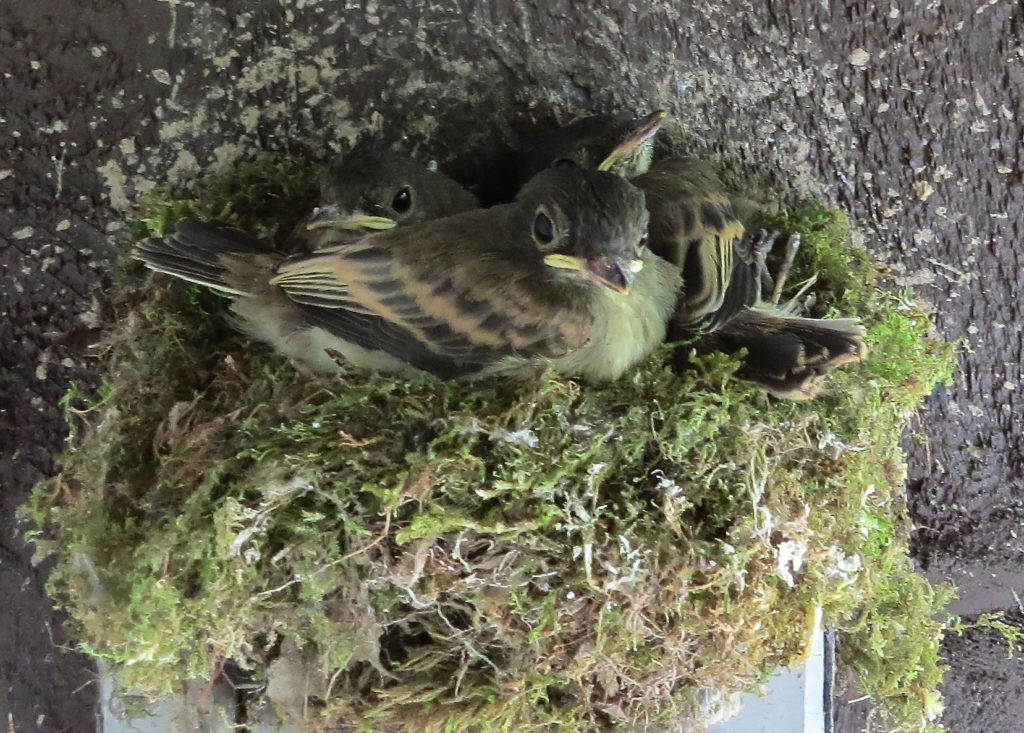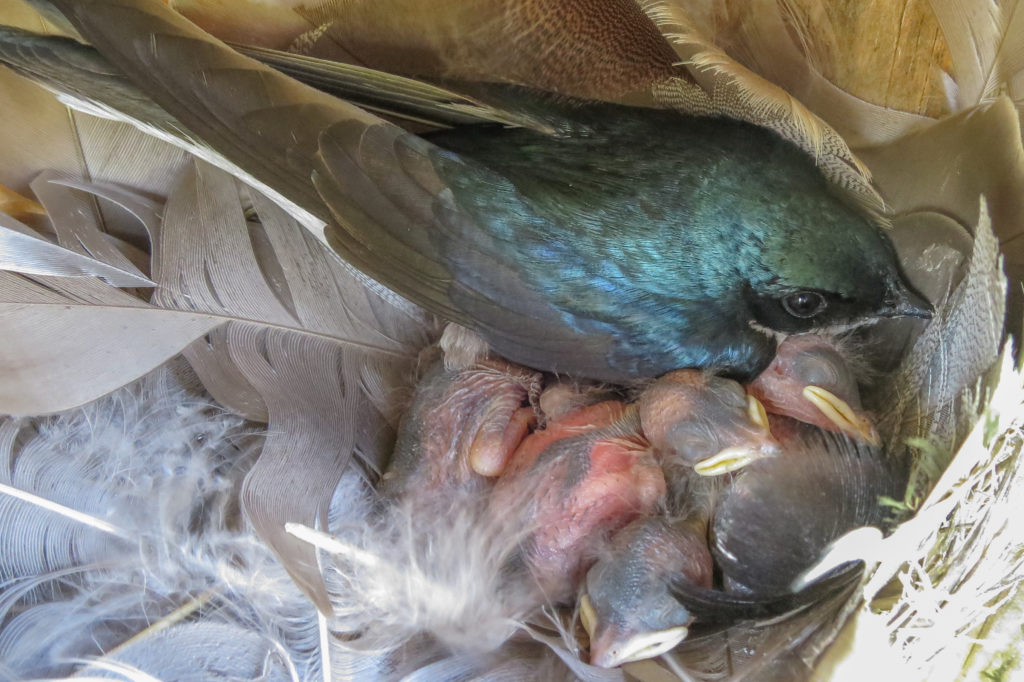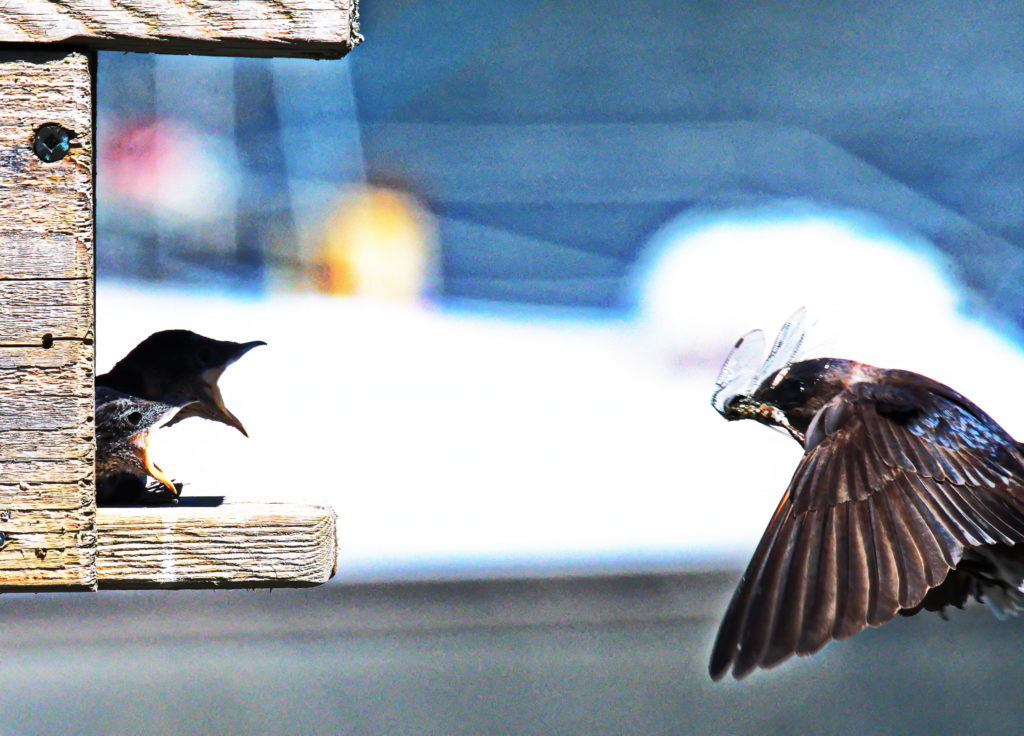Chasing a Moving Target: When insects accelerate, birds must try to keep pace
April 26, 2022
Ready To Fledge
These Eastern Phoebe nestlings need insects to grow quickly so they can leave the vulnerable nest.
By Robyn Bailey, NestWatch Project Leader
Birds have evolved to time their nesting season to coincide with the peak abundance of food in the environment, a strategy that is especially noticeable in highly seasonal environments like the northeastern United States. The food peak should ideally occur just as young are hatching and need lots of nutrients to grow up quickly. For birds that eat insects, one key nutrient the growing young need is long-chain omega-3 polyunsaturated fatty acids—usually referred to as “omega-3 fatty acids” for simplicity. Omega-3 fatty acids are essential nutrients and must be obtained from the diet for many species.
Aquatic insects have 4 to 34 times more omega-3 fatty acids than terrestrial insects. For this reason, aquatic insects (i.e., those whose larvae mature in the water) are nutritionally superior to terrestrial insects, and many birds cannot simply replace them by eating terrestrial insects without sacrificing key nutrients like omega-3s, which are critical to development and reproduction. Therefore, it is important that researchers not just count how many insects are available, but what kinds of insects and their nutritional quality.

Keeping Up With The Times
Birds that rely on insects are finding that climate change is bringing a new urgency to spring nesting season. They must time their nest to coincide with ever-earlier insect emergences.
This was the focus of a recent study which combined long-term data on both insect abundance and the timing of nesting for birds that rely on insects (Shipley et al. 2022). The scientists were able to look at both aquatic and terrestrial insect biomass from the same site in Ithaca, New York, over a 25-year period (1989-2014). They found that both aquatic and terrestrial insects have substantially advanced their emergence in association with warming early spring temperatures, by 3-12 days. The researchers wanted to know if the birds were keeping pace—that is, advancing their nesting dates to keep up with the insects.
They used data from NestWatch and Project MartinWatch (11,970 total nest records within 150 km of Ithaca, NY where insects were sampled) to investigate the relationship between shifts in egg-laying dates and those of insect emergences. They included Barn Swallows, Eastern Phoebes, Purple Martins, Eastern Bluebirds, Tree Swallows, and House Wrens, all of which primarily feed insects to their young.
Unfortunately, they found that the insectivorous birds were not keeping pace; although they advanced their lay dates to track their prey, they still lagged behind the pace of insects. The study found no annual decrease in overall insect abundance, but rather a change in when the insects were available. The insects were emerging earlier and over a shorter period, creating a punctuated pulse of insect food available to birds. Although terrestrial insects still increase throughout the season, aquatic insects peaked early and declined after May 15th. This could have negative consequences for birds that breed later in the season like Purple Martins and Tree Swallows.

Falling Out Of Sync
Late nesters like Purple Martins and Tree Swallows could experience food shortages if they are unable to advance their egg-laying dates to keep pace with advancing insect hatches.
The lead author Dr. Ryan Shipley said of the study that “It highlights the importance of having long-term data on insect communities and knowledge of whether their larval stage is aquatic or terrestrial, because they vary in their nutritional quality in terms of omega-3 fatty acids. Aerial insectivores like swallows are declining across much of North America and Europe, and we know they are chasing a fast moving and elusive target to time reproduction. Long-term nesting data, like those provided by citizen scientists, are critical to understanding these declines.”
What can people do to help?
- Protect ponds, lakes, estuaries, and wetlands (aka irreplaceable “nutrient hotspots”) from disturbances like urbanization, agricultural pesticides, and fertilizers.
- If you have a backyard or campus pond, don’t mow right up to the edge. Leave a vegetation buffer around it.
- Support policies that reduce greenhouse gas emissions.
- Encourage insects in your spheres of influence (e.g., turn off the bug zapper, put down the insecticide sprayer, and use protective clothing and bug spray to keep yourself protected).
Reference:
- Shipley, J. R., C. W. Twining, M. Mathieu-Resuge, T. P. Parmar, M. Kainz, D. Martin-Creuzburg, C. Weber, D. W. Winkler, C. H. Graham, and B. Matthews. 2022. Climate change shifts the timing of nutritional flux from aquatic insects. Current Biology 32(6):1342-1349.e3. DOI: https://doi.org/10.1016/j.cub.2022.01.057

4 comments on “Chasing a Moving Target: When insects accelerate, birds must try to keep pace”
I use mosquito dunkers for my rain barrels and any standing water in my yard. Should I be using them or not?
Hi Susan, We’re not able to comment on any specific brands, but in general we discourage use of any pesticides, insecticides, or herbicides if your aim is to create a wildlife-friendly habitat.
The swallows came back to our farm a month early this year and it was a real surprise. Problem is that the cold makes insects few so I worry a lot about how they will manage must less have babies. One year some of the chicks died when a cold snap occurred at the time they hatched. We are in upstate NY a few miles north of Plattsburgh
I live in southwest New Hampshire and the have 7 next boxes in fields on my property. 15 years ago, there were twice as many Tree Swallows showing up as could be accommodated and they would be fighting over the boxes for weeks. The last few years, there has only been one box occupied. No vegetation change — I keep the area around them clear enough to thwart the House Wrens.
I would still have some hope that the birds will continue to evolve and “catch up” to the insect life cycle. I would guess that the birds timing is genetic and requires evolution over years, whereas the insects are triggered by warming temperatures and thus respond more quickly to warming climate.
How does NestWatch utilize citizen science, and what role do ordinary people play in the data collection process?
Hello, Participants in NestWatch collect data on bird nests that they find and submit those data to our website. The data are added to our database, which is open-access and updated yearly [find it here]. We produce annual summaries of data submitted as well as provide aggregate data downloads for the general public. Please feel free to contact us at nestwatch@cornell.edu with any additional questions.
we had swallows for the first time this year and i was surprised they made a nest at the overhang of our front door. i saw the swallows flying around the front of our house but i thought they were looking for insects in flight. my wife saw the the nest and it was attache d to the vertical wall without a support. what did the swallows use to attach the nest with no support? They are feeding several baby birds in the nest. We have several birds nesting in our back yard and I buy a lot of bird seed every month at Wild Birds Unlimited.
I have been told the birds need us but we also need the birds.
Hi Walter, It sounds like you may have Barn Swallows or Cliff Swallows. These species typically build their nests on vertical walls of buildings or rock faces/caves. These nests are constructed mainly of mud; the adults bring mouthfuls of mud to the wall and slowly build out their nest from there. Barn Swallows incorporate grasses and softer materials as they go, lining their nest with feathers, while Cliff Swallows build more of a dome-shaped nest jutting out from the wall with a small opening near the bottom edge.